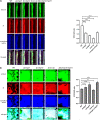The CRISPR-Cas System Differentially Regulates Surface-Attached and Pellicle Biofilm in Salmonella enterica Serovar Typhimurium
- PMID: 35678575
- PMCID: PMC9241790
- DOI: 10.1128/spectrum.00202-22
The CRISPR-Cas System Differentially Regulates Surface-Attached and Pellicle Biofilm in Salmonella enterica Serovar Typhimurium
Abstract
The CRISPR-Cas mediated regulation of biofilm by Salmonella enterica serovar Typhimurium was investigated by deleting CRISPR-Cas components ΔcrisprI, ΔcrisprII, ΔΔcrisprI crisprII, and Δcas op. We determined that the system positively regulates surface biofilm while inhibiting pellicle biofilm formation. Results of real-time PCR suggest that the flagellar (fliC, flgK) and curli (csgA) genes were repressed in knockout strains, causing reduced surface biofilm. The mutants displayed altered pellicle biofilm architecture. They exhibited bacterial multilayers and a denser extracellular matrix with enhanced cellulose and less curli, ergo weaker pellicles than those of the wild type. The cellulose secretion was more in the knockout strains due to the upregulation of bcsC, which is necessary for cellulose export. We hypothesized that the secreted cellulose quickly integrates into the pellicle, leading to enhanced pellicular cellulose in the knockout strains. We determined that crp is upregulated in the knockout strains, thereby inhibiting the expression of csgD and, hence, also of csgA and bcsA. The conflicting upregulation of bcsC, the last gene of the bcsABZC operon, could be caused by independent regulation by the CRISPR-Cas system owing to a partial match between the CRISPR spacers and bcsC gene. The cAMP-regulated protein (CRP)-mediated regulation of the flagellar genes in the knockout strains was probably circumvented through the regulation of yddx governing the availability of the sigma factor σ28 that further regulates class 3 flagellar genes (fliC, fljB, and flgK). Additionally, the variations in the lipopolysaccharide (LPS) profile and expression of LPS-related genes (rfaC, rfbG, and rfbI) in knockout strains could also contribute to the altered pellicle architecture. Collectively, we establish that the CRISPR-Cas system differentially regulates the formation of surface-attached and pellicle biofilm. IMPORTANCE In addition to being implicated in bacterial immunity and genome editing, the CRISPR-Cas system has recently been demonstrated to regulate endogenous gene expression and biofilm formation. While the function of individual cas genes in controlling Salmonella biofilm has been explored, the regulatory role of CRISPR arrays in biofilm is less studied. Moreover, studies have focused on the effects of the CRISPR-Cas system on surface-associated biofilms, and comprehensive studies on the impact of the system on pellicle biofilm remain an unexplored niche. We demonstrate that the CRISPR array and cas genes modulate the expression of various biofilm genes in Salmonella, whereby surface and pellicle biofilm formation is distinctively regulated.
Keywords: Salmonella; pellicle biofilm; surface-attached biofilm; type I-E CRISPR-Cas system.
Conflict of interest statement
The authors declare no conflict of interest.
Figures







Similar articles
-
Alteration of the rugose phenotype in waaG and ddhC mutants of Salmonella enterica serovar Typhimurium DT104 is associated with inverse production of curli and cellulose.Appl Environ Microbiol. 2006 Jul;72(7):5002-12. doi: 10.1128/AEM.02868-05. Appl Environ Microbiol. 2006. PMID: 16820499 Free PMC article.
-
Salmonella enterica serovar Typhimurium STM1266 encodes a regulator of curli biofilm formation: the brfS gene.FEMS Microbiol Lett. 2023 Jan 17;370:fnad012. doi: 10.1093/femsle/fnad012. FEMS Microbiol Lett. 2023. PMID: 36792064
-
Molecular characterization of biofilm formation and attachment of Salmonella enterica serovar typhimurium DT104 on food contact surfaces.J Food Prot. 2009 Sep;72(9):1841-7. doi: 10.4315/0362-028x-72.9.1841. J Food Prot. 2009. PMID: 19777884
-
Regulation of biofilm formation in Salmonella enterica serovar Typhimurium.Future Microbiol. 2014;9(11):1261-82. doi: 10.2217/fmb.14.88. Future Microbiol. 2014. PMID: 25437188 Review.
-
The csgD promoter, a control unit for biofilm formation in Salmonella typhimurium.Res Microbiol. 2003 Dec;154(10):659-67. doi: 10.1016/j.resmic.2003.08.005. Res Microbiol. 2003. PMID: 14643403 Review.
Cited by
-
Polyphenols and CRISPR as Quorum Quenching Agents in Antibiotic-Resistant Foodborne Human Pathogens (Salmonella Typhimurium, Campylobacter jejuni and Escherichia coli 0157:H7).Foods. 2024 Feb 15;13(4):584. doi: 10.3390/foods13040584. Foods. 2024. PMID: 38397561 Free PMC article. Review.
-
Newly Isolated Virulent Salmophages for Biocontrol of Multidrug-Resistant Salmonella in Ready-to-Eat Plant-Based Food.Int J Mol Sci. 2023 Jun 14;24(12):10134. doi: 10.3390/ijms241210134. Int J Mol Sci. 2023. PMID: 37373290 Free PMC article.
-
Phenotypic Characterization and Genome Analysis of New Broad-Spectrum Virulent Salmophage, Salmonella Phage KKP_3822, for Biocontrol of Multidrug-Resistant Salmonella enterica Strains.Int J Mol Sci. 2024 Dec 1;25(23):12930. doi: 10.3390/ijms252312930. Int J Mol Sci. 2024. PMID: 39684641 Free PMC article.
-
CRISPR-Cas system positively regulates virulence of Salmonella enterica serovar Typhimurium.Gut Pathog. 2024 Oct 26;16(1):63. doi: 10.1186/s13099-024-00653-5. Gut Pathog. 2024. PMID: 39462402 Free PMC article.
-
Analysis of bacterial pangenomes reduces CRISPR dark matter and reveals strong association between membranome and CRISPR-Cas systems.Sci Adv. 2023 Mar 24;9(12):eadd8911. doi: 10.1126/sciadv.add8911. Epub 2023 Mar 24. Sci Adv. 2023. PMID: 36961900 Free PMC article.
References
Publication types
MeSH terms
Substances
LinkOut - more resources
Full Text Sources
Research Materials
Miscellaneous

